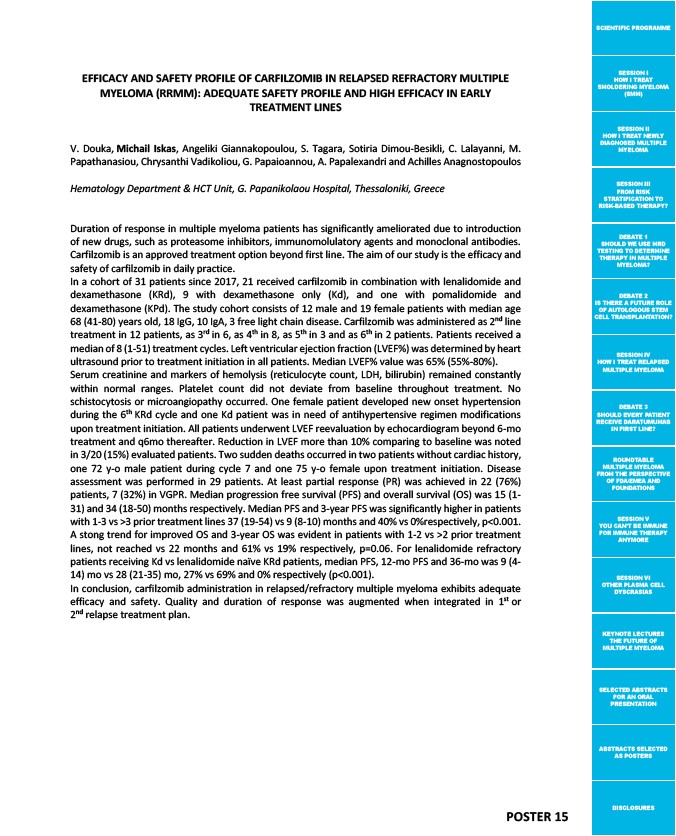
SCIENTIFIC PROGRAMME
SESSION I
HOW I TREAT
SMOLDERING MYELOMA
(SMM)
SESSION II
HOW I TREAT NEWLY
DIAGNOSED MULTIPLE
MYELOMA
SESSION III
FROM RISK
STRATIFICATION TO
RISK-BASED THERAPY?
DEBATE 1
SHOULD WE USE MRD
TESTING TO DETERMINE
THERAPY IN MULTIPLE
MYELOMA?
DEBATE 2
IS THERE A FUTURE ROLE
OF AUTOLOGOUS STEM
CELL TRANSPLANTATION?
SESSION IV
HOW I TREAT RELAPSED
MULTIPLE MYELOMA
DEBATE 3
SHOULD EVERY PATIENT
RECEIVE DARATUMUMAB
IN FIRST LINE?
ROUNDTABLE
MULTIPLE MYELOMA
FROM THE PERSPECTIVE
OF FDA/EMEA AND
FOUNDATIONS
SESSION V
YOU CAN’T BE IMMUNE
FOR IMMUNE THERAPY
ANYMORE
SESSION VI
OTHER PLASMA CELL
DYSCRASIAS
KEYNOTE LECTURES
THE FUTURE OF
MULTIPLE MYELOMA
SELECTED ABSTRACTS
FOR AN ORAL
PRESENTATION
ABSTRACTS SELECTED
AS POSTERS
EFFICACY AND SAFETY PROFILE OF CARFILZOMIB IN RELAPSED REFRACTORY MULTIPLE
DISCLOSURES POSTER 15
MYELOMA (RRMM): ADEQUATE SAFETY PROFILE AND HIGH EFFICACY IN EARLY
TREATMENT LINES
V. Douka, Michail Iskas, Angeliki Giannakopoulou, S. Tagara, Sotiria Dimou-Besikli, C. Lalayanni, M.
Papathanasiou, Chrysanthi Vadikoliou, G. Papaioannou, A. Papalexandri and Achilles Anagnostopoulos
Hematology Department & HCT Unit, G. Papanikolaou Hospital, Thessaloniki, Greece
Duration of response in multiple myeloma patients has significantly ameliorated due to introduction
of new drugs, such as proteasome inhibitors, immunomolulatory agents and monoclonal antibodies.
Carfilzomib is an approved treatment option beyond first line. The aim of our study is the efficacy and
safety of carfilzomib in daily practice.
In a cohort of 31 patients since 2017, 21 received carfilzomib in combination with lenalidomide and
dexamethasone (KRd), 9 with dexamethasone only (Kd), and one with pomalidomide and
dexamethasone (KPd). The study cohort consists of 12 male and 19 female patients with median age
68 (41-80) years old, 18 IgG, 10 IgA, 3 free light chain disease. Carfilzomib was administered as 2nd line
treatment in 12 patients, as 3rd in 6, as 4th in 8, as 5th in 3 and as 6th in 2 patients. Patients received a
median of 8 (1-51) treatment cycles. Left ventricular ejection fraction (LVEF%) was determined by heart
ultrasound prior to treatment initiation in all patients. Median LVEF% value was 65% (55%-80%).
Serum creatinine and markers of hemolysis (reticulocyte count, LDH, bilirubin) remained constantly
within normal ranges. Platelet count did not deviate from baseline throughout treatment. No
schistocytosis or microangiopathy occurred. One female patient developed new onset hypertension
during the 6th KRd cycle and one Kd patient was in need of antihypertensive regimen modifications
upon treatment initiation. All patients underwent LVEF reevaluation by echocardiogram beyond 6-mo
treatment and q6mo thereafter. Reduction in LVEF more than 10% comparing to baseline was noted
in 3/20 (15%) evaluated patients. Two sudden deaths occurred in two patients without cardiac history,
one 72 y-o male patient during cycle 7 and one 75 y-o female upon treatment initiation. Disease
assessment was performed in 29 patients. At least partial response (PR) was achieved in 22 (76%)
patients, 7 (32%) in VGPR. Median progression free survival (PFS) and overall survival (OS) was 15 (1-
31) and 34 (18-50) months respectively. Median PFS and 3-year PFS was significantly higher in patients
with 1-3 vs >3 prior treatment lines 37 (19-54) vs 9 (8-10) months and 40% vs 0%respectively, p<0.001.
A stong trend for improved OS and 3-year OS was evident in patients with 1-2 vs >2 prior treatment
lines, not reached vs 22 months and 61% vs 19% respectively, p=0.06. For lenalidomide refractory
patients receiving Kd vs lenalidomide naïve KRd patients, median PFS, 12-mo PFS and 36-mo was 9 (4-
14) mo vs 28 (21-35) mo, 27% vs 69% and 0% respectively (p<0.001).
In conclusion, carfilzomib administration in relapsed/refractory multiple myeloma exhibits adequate
efficacy and safety. Quality and duration of response was augmented when integrated in 1st or
2nd relapse treatment plan.